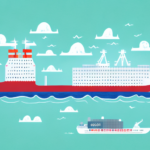Understanding Ocean Shipping Rates for UPS: A Comprehensive Guide
In the realm of international trade, comprehending ocean shipping rates is essential for optimizing logistics and ensuring cost-effective transportation of goods. UPS, a global leader in logistics and transportation, offers a variety of ocean shipping options tailored to both businesses and individuals. To secure the best shipping rates and meet your specific needs, it's crucial to understand how UPS's ocean shipping rates function. This guide provides a detailed breakdown of everything you need to know.
Why Understanding Ocean Shipping Rates for UPS is Crucial
Grasping the intricacies of international shipment rates is vital for effective budgeting and cost management. Ocean shipping rates can be complex, and a lack of understanding may lead to overspending. By thoroughly understanding these rates, businesses can:
- Budget Accurately: Plan finances effectively to enhance profit margins or offer competitive pricing.
- Avoid Unexpected Fees: Stay informed about regulations and requirements to prevent additional charges or shipment delays.
- Optimize Supply Chain: Make informed decisions that enhance operational efficiency and reduce overall costs.
For instance, according to a 2023 shipping industry report, businesses that actively manage their shipping costs see an average profit increase of 12%.
The Basics of Ocean Shipping Rates for UPS
UPS's ocean shipping rates encompass the expenses related to transporting goods internationally by sea. These rates fluctuate based on factors such as distance, weight, volume, and the nature of the cargo. Generally, larger shipments benefit from lower costs per unit of weight or volume.
UPS offers various ocean shipping services, including:
- Full Container Load (FCL): Ideal for shipments occupying an entire container, providing flexibility and space for large volumes.
- Less than Container Load (LCL): Suitable for smaller shipments that do not require a full container, optimizing costs by sharing space with other shippers.
Additionally, UPS ensures comprehensive tracking and real-time updates throughout the shipping process, enhancing transparency and reliability.
Types of Ocean Shipping Rates Offered by UPS
UPS provides several ocean shipping rate options to cater to diverse shipping needs:
- LCL (Less than Container Load): Best for shipments that do not fill an entire container. Sharing space with other shipments reduces costs, although it may result in longer shipping times.
- FCL (Full Container Load): Suitable for large shipments requiring a full container. Offers greater flexibility and space but comes at a higher cost.
- Reefer Containers: Designed for perishable goods requiring temperature control, such as fruits, vegetables, and pharmaceuticals.
- Flat Rack Containers: Ideal for oversized or irregularly shaped cargo like machinery, vehicles, and construction materials.
Each container type caters to specific shipping requirements, ensuring that goods are transported efficiently and safely.
How to Calculate Ocean Shipping Rates for UPS
Calculating ocean shipping rates involves evaluating several factors, including:
- Origin and Destination: The distance between the shipping points significantly impacts the cost.
- Weight and Volume: Heavier and larger shipments incur higher costs.
- Type of Cargo: Specialized goods may require additional handling, affecting the rate.
To estimate your ocean shipping fees, utilize the UPS Shipping Calculator available on the UPS official website. Alternatively, contacting a UPS representative can provide a detailed and customized shipping quote.
It's important to recognize that shipping rates can fluctuate based on seasonal demands and market conditions. For example, peak seasons like the holiday period often see higher rates due to increased demand. Additionally, shipping hazardous materials may entail extra fees for special handling and packaging. Consulting with a UPS representative ensures access to the most accurate and current rate information.
Factors Influencing Ocean Shipping Rates for UPS
Several elements can affect the cost of ocean shipping with UPS:
- Shipping Distance: Longer distances generally result in higher shipping costs.
- Shipment Size and Weight: Larger and heavier shipments cost more to transport.
- Type and Value of Goods: High-value or fragile items may require specialized handling, increasing rates.
- Origin and Destination Ports: Charges can vary based on the specific ports involved in the shipment.
- Mode of Transportation: Choices between air, sea, and ground transportation impact the overall cost, with air typically being more expensive but faster.
Understanding these factors can help businesses make strategic decisions to manage and reduce shipping costs effectively.
Strategies to Reduce Your Ocean Shipping Rates with UPS
While ocean shipping can be expensive, implementing the following strategies can help lower your shipping costs:
- Negotiate Rates: Establish long-term relationships with UPS to qualify for discounts and customized shipping solutions.
- Optimize Shipping Volume: Consolidate shipments and maximize container utilization to benefit from bulk discounts.
- Plan Ahead: Schedule shipments in advance to avoid rush fees and take advantage of lower rates during off-peak times.
- Stay Informed: Keep up-to-date with shipping regulations and fee changes to adjust your strategies accordingly.
- Use Third-Party Logistics Providers: Collaborate with experts who can navigate ocean shipping complexities and secure the best rates.
Additionally, efficient packing and choosing the most cost-effective shipping methods can further reduce expenses. According to a 2023 logistics survey, businesses that consolidate shipments can reduce their shipping costs by up to 15%.
Understanding Freight Classifications and Their Impact on Shipping Rates with UPS
Freight classification is a system used to categorize goods for pricing purposes. Accurate classification is critical as it influences the shipping rates charged by UPS. Misclassification can lead to delays and increased shipping costs.
Factors determining freight classification include:
- Weight and Density: Heavier and denser goods may fall under different classifications impacting the rate.
- Value: High-value items may require additional security measures, affecting the cost.
- Handling Requirements: Fragile or perishable goods may need special packaging or handling, influencing their classification.
To ensure accurate classification:
- Measure and weigh your products precisely.
- Understand the specific classification criteria relevant to your goods.
- Consult UPS guidelines or a logistics expert if unsure.
Proper freight classification ensures shipments are processed smoothly and cost-effectively, avoiding unnecessary expenses and delays.
How to Negotiate Better Ocean Shipping Rates with UPS
Negotiating favorable ocean shipping rates with UPS involves several strategies:
- Build Long-Term Relationships: Regular customers often receive discounts and customized shipping solutions.
- Compare Rates: Analyze rates from different logistics providers to leverage competitive pricing during negotiations.
- Leverage Volume and Frequency: Higher shipment volumes and regular shipping frequencies can be bargaining chips for better rates.
- Optimize Shipment Timing: Schedule shipments during off-peak periods to benefit from lower rates compared to peak seasons.
- Explore Alternative Methods: Consider intermodal transportation, which combines multiple transportation modes to reduce costs.
For example, intermodal transportation can decrease shipping costs by utilizing more economical modes like rail or sea where feasible, as highlighted in a 2023 intermodal transport study.
Common Mistakes to Avoid When Calculating Ocean Shipping Rates with UPS
To ensure accurate and cost-effective shipping, avoid the following common mistakes when calculating ocean shipping rates with UPS:
- Incorrect Value Declaration: Misstating the value of goods can result in higher shipping rates and potential legal issues.
- Wrong Freight Classification: Using an incorrect classification leads to inaccurate rate calculations and possible delays.
- Poor Measurement and Packing: Inaccurate measurements and inefficient packing can increase costs and complicate logistics.
- Ignoring Seasonal Variations: Failing to account for peak and off-peak season rates can lead to unexpected expenses.
- Overlooking Customs Regulations: Not considering the destination country's customs rules can cause delays, fines, or shipment seizures.
By meticulously managing these aspects, businesses can enhance their shipping efficiency and maintain cost-effectiveness.
In conclusion, understanding ocean shipping rates for UPS is indispensable for anyone engaged in international trade. It empowers you to make informed shipping decisions, minimize unexpected costs, and optimize your supply chain for greater profitability. By exploring the different ocean shipping options offered by UPS, accurately calculating shipping costs, and employing strategies to reduce expenses, you can effectively manage your shipping operations and enhance your business's financial health.




















